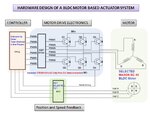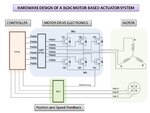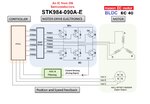umargill
Junior Member level 1
- Joined
- Oct 3, 2010
- Messages
- 18
- Helped
- 0
- Reputation
- 0
- Reaction score
- 0
- Trophy points
- 1,281
- Location
- Daejeon, South Korea
- Activity points
- 1,443
View attachment Three Phase Bridge IC Super Best.PDFView attachment MAXON EC 40 BLDC Motor.pdf

Respected All Readers and Electronics Experts,
Hello and a Good Day to all of you.
Its my 4th or 5th post on EDA Forum ever since I joined it. Fortunately, I always found excellent solutions to my queries, hence my experience here has been excellent and I hope for the same this time again.
This time, as the subject of this thread illustrates, me and my team intends to monitor and control the motion of a BLDC (Brushless DC) Motor using a FPGA. Our team comprises of two sections, with the one dealing in Digital Aspects (FPGA / Motor Controller) while me responsible for selecting hardware components in Analogue domain (Motor, Motor Drive Electronics, ADC).
The BLDC Motor should have the following properties: Power(<=120 Watt), Speed (10,000 RPM), Feedback (Sensored/ Hall Effect).
(A) I have selected a MAXON EC 40 BLDC Motor datasheet of which is attached here. It has Power(<=120 Watt), Operating Voltage (24 Volt), Speed (10,000 RPM) and Built-In Feedback (Sensored/ Hall Effect).
(B) I have also selected a Three Phase Bridge IC manufactured by On Semiconductors (STK984-091A-E)
(C) The ADC as shown in the attached picture is yet to be selected. The purpose of this ADC is to receive analogue output from Motor's Hall Effect Sensors, convert it to digital format and then feed into the FPGA.
(D) The FPGA (NOT my Part in this project) will receive the digital signal from ADC, determine the position and speed of the rotor, and will then issue PWM signals required to run the motor at any specific speed.
Now what are my Questions?
(A) Using your expertise, please VALIDATE the integration of the two components I selected so far i-e Motor and the Drive Electronics. You may also suggest me some other alternatives.
(B) Please suggest me an ADC Chip that may fit into this system.
(C) Is my approach CORRECT?
(D) It will be a great help if somebody reply me with a fully functional system based on His/Her Experience. In this case, you can simply type the names of the components into the image attached with the name (Your Design).
Thanking you in advance for viewing this thread and I will highly appreciate your input in this project.
Regards:
Umar Shafiq
PhD Student
Aerospace Engineering Department
KAIST, South Korea

Respected All Readers and Electronics Experts,
Hello and a Good Day to all of you.
Its my 4th or 5th post on EDA Forum ever since I joined it. Fortunately, I always found excellent solutions to my queries, hence my experience here has been excellent and I hope for the same this time again.
This time, as the subject of this thread illustrates, me and my team intends to monitor and control the motion of a BLDC (Brushless DC) Motor using a FPGA. Our team comprises of two sections, with the one dealing in Digital Aspects (FPGA / Motor Controller) while me responsible for selecting hardware components in Analogue domain (Motor, Motor Drive Electronics, ADC).
The BLDC Motor should have the following properties: Power(<=120 Watt), Speed (10,000 RPM), Feedback (Sensored/ Hall Effect).
(A) I have selected a MAXON EC 40 BLDC Motor datasheet of which is attached here. It has Power(<=120 Watt), Operating Voltage (24 Volt), Speed (10,000 RPM) and Built-In Feedback (Sensored/ Hall Effect).
(B) I have also selected a Three Phase Bridge IC manufactured by On Semiconductors (STK984-091A-E)
(C) The ADC as shown in the attached picture is yet to be selected. The purpose of this ADC is to receive analogue output from Motor's Hall Effect Sensors, convert it to digital format and then feed into the FPGA.
(D) The FPGA (NOT my Part in this project) will receive the digital signal from ADC, determine the position and speed of the rotor, and will then issue PWM signals required to run the motor at any specific speed.
Now what are my Questions?
(A) Using your expertise, please VALIDATE the integration of the two components I selected so far i-e Motor and the Drive Electronics. You may also suggest me some other alternatives.
(B) Please suggest me an ADC Chip that may fit into this system.
(C) Is my approach CORRECT?
(D) It will be a great help if somebody reply me with a fully functional system based on His/Her Experience. In this case, you can simply type the names of the components into the image attached with the name (Your Design).
Thanking you in advance for viewing this thread and I will highly appreciate your input in this project.
Regards:
Umar Shafiq
PhD Student
Aerospace Engineering Department
KAIST, South Korea


